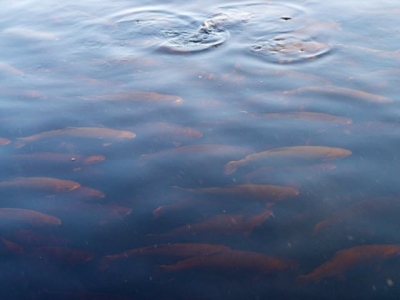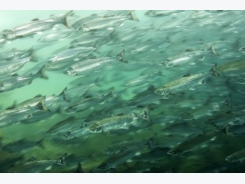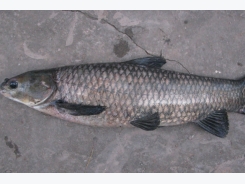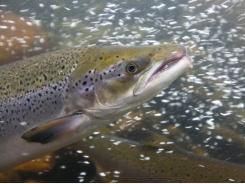Tallow may offer lipid option for salmon feed

Salmon may see a new feed ingredient in tallow, which maintains growth and improves fillet quality.
A group of Australian researchers tested tallow (TAL) as a replacement lipid source in salmon feed in a large-scale farm study designed to look at digestibility and effects from the product’s use during a winter grow-out period.
Final product was also assessed as little research on that area was available, they said.
“These results demonstrate that TAL can be safely and efficiently included in aquafeed formulations up to 40% of total added dietary lipids without any detrimental impacts on fish performance and final product quality or consumer acceptance,” they said. “Conversely, TAL inclusion results in a positive impact on fillet quality with a remarkably reduced n − 6:n − 3 [omega 6 to omega 3] ratio, and also an improvement, albeit minor, in n − 3 LC-PUFA [ omega 3 long-chain polyunsaturated fatty acids] utilization and deposition in fish tissues.”
Why tallow
As fish oil becomes harder to acquire and more expensive, alternative energy sources for salmon and aquafeed need to be found, said researchers. The inclusion of alternative lipid sources in diets commercially raised seafood has become an accepted practice.
In Europe vegetable oil is often used, while in North and South American animal-based products like poultry by-product (PbO) oil are more frequently used, they said. However, poultry by-product oil is now becoming more expensive and harder to access.
Tallow, rendered beef or mutton fat, is now be considered as an alternative animal-based product that does not have similar competing interests altering prices, they said. However, some questions remain about feed digestibility when it is included.
“TAL contains a high saturated fatty acids (SFA) content relative to many alternative lipid sources and it is well demonstrated that this can have a negative impact in reducing lipid digestibility (Bureau and Meeker, 2010), with impacts further exacerbated by reductions in water temperature (Cho and Kaushik, 1990, Hua and Bureau, 2009 and Ng et al., 2007),” they said.
But it also has some advantages as it had balanced levels of SFA and low omega-6 polyunsaturated fatty acids (n-6 PUFA), they said.
The experiment also was run to test initial, in-vivo laboratory findings, they said.
Experiment details
In the experiment, 1,800 Atlantic salmon given one of two commercially produced trial diets for 195 days said researchers. These included a diet with 20% fish oil and 80% PbO and the same basal diet with 20% fish oil, 40% tallow and 40% PbO.
Prior to the trial, a sample of fish was harvested for analysis, they said, and a sample was gathered for fecal collection at the end of the trial. Fecal material was assessed for digestibility.
At the end of the trial, all fish were weighed and 42 fish from each treatment were used to measure biometry for the chemical analysis of fillet, for analysis of the whole body and for sensory analysis by taste test, they said.
Growth, feed consumption and mortality were noted during the trial, they said. And, feed utilization, weight gain, feed ration %, specific growth rate (SGR), food conversion ratio (FCR), dress out % (DO%) fillet yield (FY%) condition (K) hepatosomatic index (HIS%) and viscera-somatic index (VSI%) were calculated.
Results
Both diets were eaten by fish and mortality was low, but unrelated to diet, said researchers. No significant differences in any biometrical parameters were determined in the fish.
“TAL inclusion had no significant impact on nutrient ADC% including no impact on lipid digestibility,” they said. “This is a prominent finding of this study as the potential negative impact of TAL on lipid digestibility is a key limiting concern preventing TAL inclusion in commercial aquafeed formulations.”
Fish gained about 130% of their initial body weight and had a FCR of about 1.25 with a SGR of .44%/day, they said. Fish getting the trial diet had a greater feed intake.
No differences in apparent digestibility were seen between the diets, said researchers, they said. Fillet composition also was similar.
“TD exhibited a slight significant increase in n − 3 LC PUFA content, mainly attributable to minor significant increases in both 20:5n − 3 and 22:6n − 3. The n − 6/n − 3 ratio was significantly reduced in TAL (1.2) compared with CD (1.5),” they said.
Whole body total SFA content was slightly higher for the fish getting the test diet and they had a higher n-6:n-3 PUFA ratio, said researchers. No difference in total monounsaturated fatty acids was found.
The control diet did have a greater level of in vivo enzyme elongation, they said. But, no other significant differences were found in enzyme activity.
In a sensory analysis no differences were found between fish on either diet, they said.
Related news
Tools

Phối trộn thức ăn chăn nuôi

Pha dung dịch thủy canh

Định mức cho tôm ăn

Phối trộn phân bón NPK

Xác định tỷ lệ tôm sống

Chuyển đổi đơn vị phân bón

Xác định công suất sục khí

Chuyển đổi đơn vị tôm

Tính diện tích nhà kính

Tính thể tích ao




 Do pineapple trimmings have a place in aquafeed?
Do pineapple trimmings have a place in aquafeed?  Farmed salmon are as fertile as wild salmon
Farmed salmon are as fertile as wild salmon